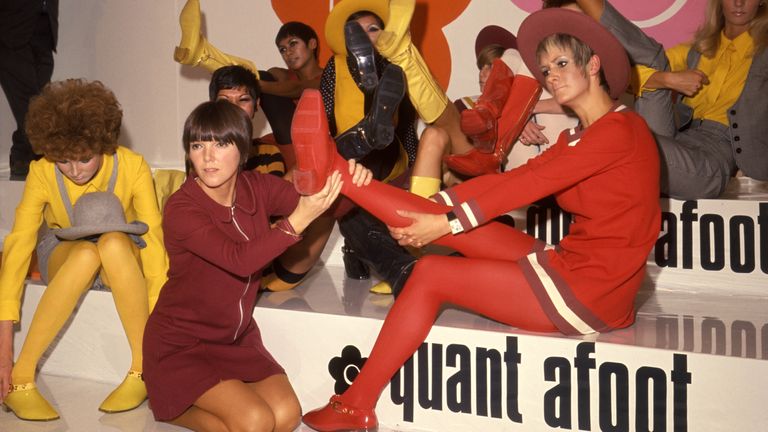Dame Mary Quant's family confirm death of 'internationally recognised' style icon
One of the most influential figures in the fashion scene of the 1960s as a pioneer of the mini-skirt and hot pants, Dame Mary Quant is credited with making fashion accessible to the masses with her sleek, streamlined and vibrant designs.
Thursday 13 April 2023 19:58, UK
The fashion designer Mary Quant has died, her family have said.
She was 93 and well-known as a pioneer of the mini-skirt and hot pants.
The Victoria & Albert Museum website says there is "no conclusive evidence" to say who first adopted a mini-skirt look.
But for Dame Mary, it became a trademark of her style.
She was one of the most influential figures in the fashion scene of the 1960s and is credited with making fashion accessible to the masses with her sleek, streamlined and vibrant designs.
A statement released on behalf of her family said: "Dame Mary Quant died peacefully at home in Surrey, UK, this morning.
"Dame Mary, aged 93, was one of the most internationally recognised fashion designers of the 20th century and an outstanding innovator of the Swinging Sixties.
"She opened her first shop Bazaar in the Kings Road in 1955 and her far-sighted and creative talents quickly established a unique contribution to British fashion."
Bazaar was one of the few shops in London that offered a radically different shopping experience - with loud music, free drinks and late opening hours.
Alexandra Shulman, former editor-in-chief of British Vogue, paid tribute to Dame Mary, writing on Twitter: "RIP Dame Mary Quant. A leader of fashion but also in female entrepreneurship - a visionary who was much more than a great haircut."
The V&A Museum, which recently hosted an exhibition about Dame Mary's designs, tweeted: "It's impossible to overstate Quant's contribution to fashion.
"She represented the joyful freedom of 1960s fashion, and provided a new role model for young women.
"Fashion today owes so much to her trailblazing vision."
Jenny Lister, the curator of the Dame Mary Quant exhibition at the V&A, said the fashion designer "blasted through barriers of snobbery and tradition" and will "always represent the joyful freedom of fashion in the 1960s".
"With her unique sense of humour, style, and determination to democratise and share the fun and creativity of her designs, she provided a new kind of role model for young women, creating a space for them to be themselves," she said.
"She helped to define Britain's global identity as a centre of streetstyle and innovation, with signature looks such as PVC macs, colourful tights, and the skinny-rib sweater."
Be the first to get Breaking News
Install the Sky News app for free


Dame Mary was the daughter of two Welsh teachers but was born in Blackheath, London, in 1930.
She gained a diploma in the 1950s in art education at Goldsmiths College, where she met her husband Alexander Plunket Greene, who later helped establish her brand.
She was married to him until his death in 1990. The couple had a son, Orlando, who was born in 1970.
In 2014, she was made a dame for services to British fashion in the Queen's New Year Honours list.
The same year, Dame Mary, who named the mini-skirt after her favourite make of car, recalled its "feeling of freedom and liberation".
She said: "It was the girls on King's Road who invented the mini. I was making clothes which would let you run and dance and we would make them the length the customer wanted.
"I wore them very short and the customers would say, 'shorter, shorter'."
Dame Mary also revolutionised the high street with trousers for women, as well as accessories, tights and make-up, while using the daisy brand design that became synonymous with her creations.
Her clothes were popularised by models Twiggy, Jean Shrimpton and Pattie Boyd, and singer Cilla Black.







